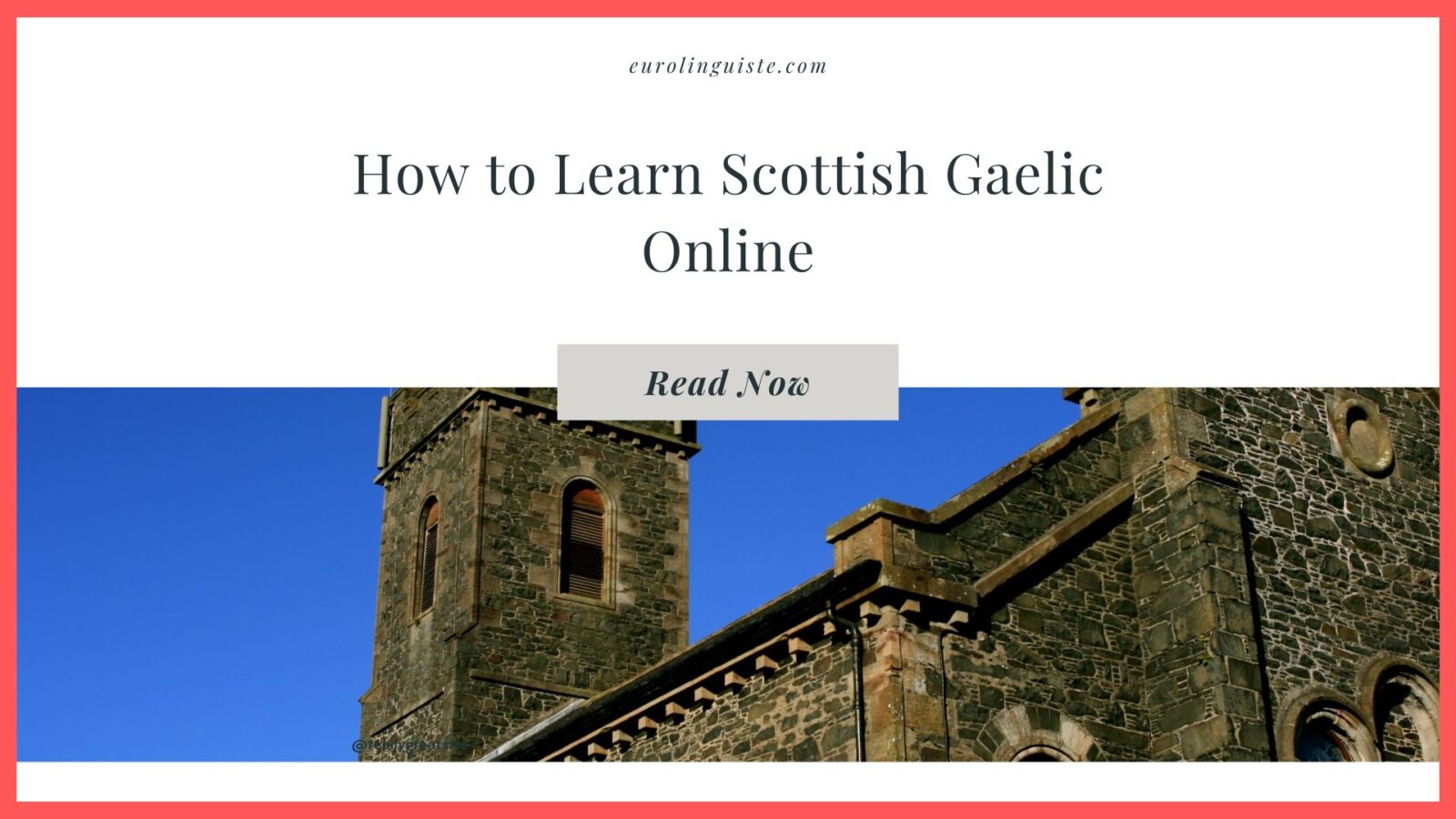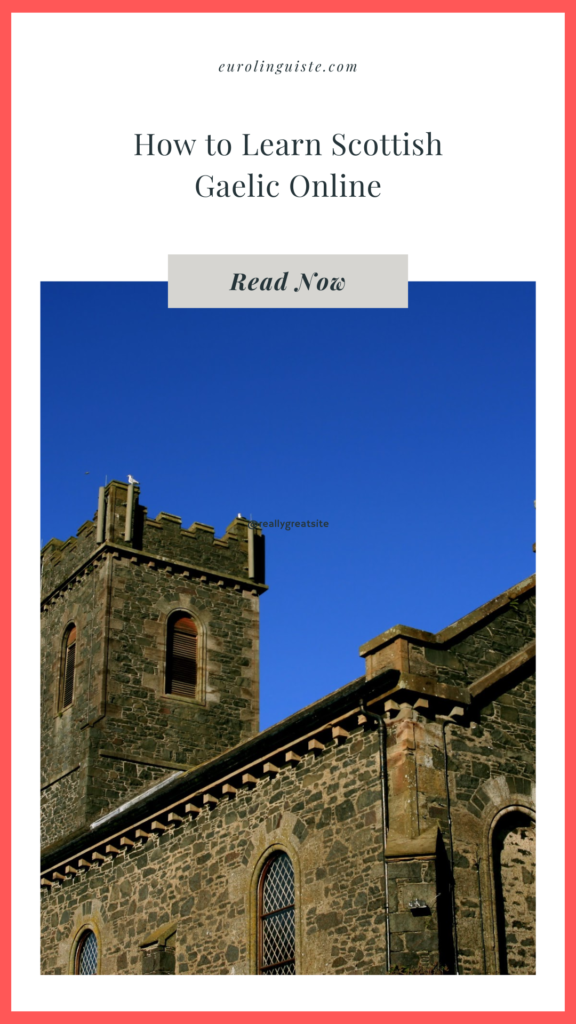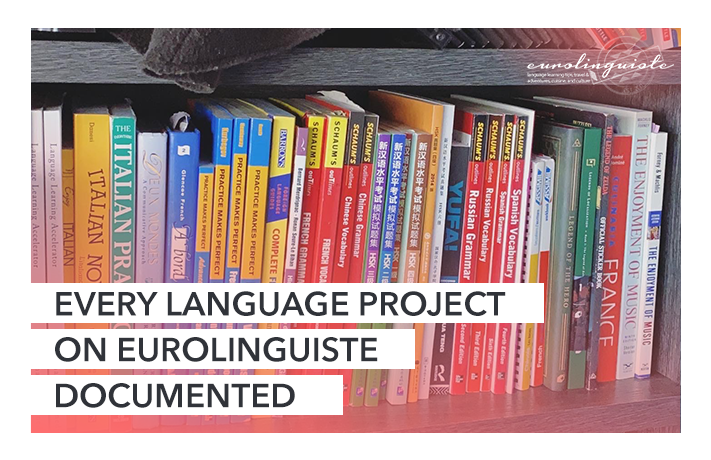How to Learn Scottish Gaelic Online

My name is Shannon Kennedy and I'm the language lover,…
Each time I pick up a new language, I’m convinced it’s my last. And yet, despite my certainty, I find myself drawn to explore new languages.
So, when I felt the call to pick up Scottish Gaelic this last year, I wasn’t surprised.
Scottish Gaelic, a member of the Celtic languages family, isn’t widely learned, so it’s a little more challenging when compared to many other languages.
With the help of some friends as well as some independent research, I’ve managed to find quality resources that have helped me learn Scottish Gaelic online.
Here’s how I’m doing it.
Before we get too far, this post contains affiliate links. This means that if you make a purchase through one of these links, I’ll receive a small commission at no extra cost to you. If you enjoy Eurolinguiste, please consider purchasing from my affiliate links to help support what I do.
A Little Bit About Scottish Gaelic
Scottish Gaelic is a Celtic language native to Scotland. It is part of the Goidelic branch of the Celtic language family, closely related to Irish and Manx. Other languages in the Celtic language family are of the Brythonic branch: Cornish, Breton, and Welsh.
Historically spoken throughout Scotland, Scottish Gaelic’s usage has declined over the centuries, but it remains vibrant in the Outer Hebrides and some parts of the Highlands. Gaelic has a rich oral tradition, with poetry, songs, and storytelling playing crucial roles in its cultural heritage. If you learn the language as part of a course or with a teacher, you can almost certainly expect to learn songs and even sing!
The language features a unique spelling system and grammar, including the absence of words for “yes” and “no” and the conjugation of prepositions. I’ll talk more about some of it’s unique grammar features below.
Scottish Gaelic is considered an endangered language with around 57,000 speakers (as of a 2011 census). Efforts to revive and promote Gaelic include:
- Educational Programs: Gaelic-medium education (GME) schools and classes are available, where subjects are taught in Gaelic.
- Media and Broadcasting: There are Gaelic television channels, such as BBC Alba, and radio stations, as well as online content to promote and preserve the language.
- Community Initiatives: Local organizations and community groups often work to encourage the use of Gaelic in daily life through events, workshops, and cultural activities.
- Government Support: The Scottish government supports various initiatives to promote the learning and use of Gaelic, including funding for language development and preservation projects.
The Basics of Learning Scottish Gaelic: The Alphabet and Pronunciation
At first glance, the Gaelic spelling system might seem intimidating, especially with its consonant combinations that aren’t immediately intuitive to English speakers. However, unlike English, Gaelic’s spelling is quite consistent and the system is phonetic so words are generally spelled as they are pronounced. Once you learn the rules, you’ll find it much more manageable.
The Scottish Gaelic Alphabet
The Scottish Gaelic alphabet, derived from the Latin script, consists of 18 letters: A, B, C, D, E, F, G, H, I, L, M, N, O, P, R, S, T, and U. Unlike English, it excludes the letters J, K, Q, V, W, X, Y, and Z.
The alphabet features unique diacritical marks, primarily the grave accent (`) over vowels (à, è, ì, ò, ù) to indicate length and stress.
Scottish Gaelic Pronunciation
Consonant combinations and mutations play a significant role in the language. These combinations often differ significantly from those in English, leading to unique sounds.
For example, the combination “bh” is typically pronounced as a “v” sound, while “mh” can sound like a “v” or “w,” depending on its position in a word. The “ch” combination is pronounced as a guttural sound, similar to the “ch” in the German word “Bach.” Additionally, “dh” and “gh” often represent a soft, throaty sound.
In Gaelic, consonants can sound different depending on the vowels next to them. If a consonant is next to “e” or “i”, it has a lighter sound (slender). If it is next to “a”, “o”, or “u”, it has a heavier sound (broad). Understanding this helps you pronounce words correctly in Scottish Gaelic.
Here’s a guide to Scottish Pronunciation.
Understanding Scottish Gaelic Grammar
Scottish Gaelic grammar presents some intriguing differences from English.
There’s No “Yes” or “No” in Scottish Gaelic
To start, there is no direct way to say “yes” or “no” in Scottish Gaelic. This isn’t unique to the language. Surprisingly, it’s the same for Mandarin Chinese, Irish, Welsh, Cantonese, Latin, and even Finnish.
For example:
Are you Scottish?
Am (yes). Am not (no).
Were you in Scotland?
Was (yes). Was not (no).
Are you reading?
Reading (yes). Am not reading (no).
Word Order
Word order in Scottish Gaelic is verb-subject-object (in comparison, English is subject-verb-object). Prepositions usually precede their objects and adjectives come after the words they describe.
There is some flexibility with word order, and you can often move things around in a sentence to emphasize certain parts of what you have to say.
Prepositions in Scottish Gaelic
Scottish Gaelic conjugates prepositions. It also forms contractions between prepositions and pronouns. For instance, air (meaning “on”) has forms like “orm” (on me), “ort” (on you), and so forth. You’ll encounter these often because Gaelic frequently uses prepositional phrases to express ideas that English conveys differently. For example, to say “I have a cat” in Gaelic, you’d say “tha cat agam,” which translates literally to “a cat is at me.”
Grammatical Gender
Scottish Gaelic has grammatical gender for nouns. Nouns are either masculine or feminine. The gender of a noun is not always predictable based on its meaning, so it is important to learn the gender along with the noun itself. Fro example, boireannach (“woman”) is grammatically masculine, not feminine as you might assume.
Gender affects articles, adjectives, and pronouns, which must agree with the gender of the noun they modify.
Scottish Gaelic Conjugation
In Scottish Gaelic, verbs are conjugated to reflect the subject, tense, and mood of the sentence. Verbs can be regular or irregular, with irregular verbs often having unique conjugation patterns. Scottish Gaelic verbs also undergo lenition (softening) or other changes depending on their position in a sentence or the words around them.
What is lenition?
Lenition is indicated by adding an h after the initial consonant or by causing other changes to the word. This change often occurs in certain grammatical contexts, such as after certain prepositions or in certain verb forms. Lenition can alter the meaning or grammatical function of a word and is an important aspect of Scottish Gaelic grammar.
Why Scottish Gaelic is Easier to Learn Than You Might Think
Don’t let Scottish Gaelic’s unique grammatical features and pronunciation scare you away. The language can be considered easy and fun to learn for many reasons.
- Phonetic Spelling: Scottish Gaelic words are generally spelled phonetically, meaning they are pronounced as they are written once you learn the pronunciation rules.
- Regular Grammar: While the grammar can be complex, it is also regular and systematic, which can make it easier to learn once you grasp the basic rules.
- Familiar Vocabulary: English speakers may find some Gaelic words familiar, as there are shared roots between Gaelic and English vocabulary.
- Small Community, Strong Resources: While not as widely spoken as some languages, Scottish Gaelic has a strong community of speakers and learners, which means there are many resources available for learning and practice.
- Cultural Resources: Learning Scottish Gaelic often involves engaging with rich cultural resources such as music, literature, and folklore, which can make the learning experience more enjoyable and immersive.
Online Resources for Scottish Gaelic
Before diving into the language, I searched far and wide for resources that would support my efforts. Here are the resources that I’m currently using or have earmarked for use in the near future:
Gaelic with Jason
I first dove into Jason’s free videos on his Youtube channel and shortly followed up with his courses available through his website.
I was drawn to his lessons in particular because he has a clear way of explaining the language and teaches through entertaining lessons. He even has materials to learn Scottish Gaelic via Outlander and the Witcher. And I know the former has had a big influence on recent interest in the language.
Glossika
Normally you need to pay for a subscription to tap into Glossika’s full potential, but due to Scottish Gaelic’s status as an endangered language, Glossika offers its course for free.
You can read my review of Glossika here.
Duolingo
The Duolingo Scottish Gaelic course is designed to introduce learners to the basics of the language in a fun and interactive way. The course covers essential vocabulary, grammar, and pronunciation through a series of lessons and exercises.
Speak Gaelic
Speak Gaelic is a free online resource produced by MG ALBA, the BBC and Sabhal Mòr Ostaig.
Learn Gaelic
Another free online resource, Learn Gaelic has a flashcard-style course, a more involved, dialog-based course called Beag air Beag and a course based on a tv program from the 90’s. The materials are a little dated feeling, but useless nonethelss.
Colloquial Gaelic
This is the coursebook that I’m currently using. I’ve enjoyed this series for many other languages, so it was a natural step for me to pick it up for Scottish Gaelic as well. You can access audio content for this course online for free.
Teach Yourself Gaelic
I’m a big fan of the content put out by Teach Yourself, and this coursebook (Amazon affiliate link) is no exception. Each chapter is based on a dialogue and you can access the audio online for free.
Gràmar Na Gàidhlig by Michael Bryne
This is a highly recommended book and reference for Scottish Gaelic grammar (Amazon affiliate link).
A Gaelic Alphabet: a guide to the pronunciation of Gaelic letters and words by George McLennan
If you want to dive deeper with the alphabet and Scottish Gaelic pronunciation (Amazon affiliate link), this book gives you what you need to do it.
More Advanced Scottish Gaelic Resources
If you’re already past the basics in Scottish Gaelic, here are some native resources to improve your skills in the language:
And if you want to deep dive into even more Scottish Gaelic resources beyond those mentioned here this Reddit thread is the place to do it.
Learning Scottish Gaelic is a rewarding experience. While it may present some challenges, the language’s phonetic spelling and regular grammar can make it approachable.
The rich culture associated with Scottish Gaelic, combined with the availability of resources like the Duolingo course, provides an immersive and enjoyable learning journey. Whether for its cultural value, linguistic uniqueness, or personal interest, learning Scottish Gaelic can be a fulfilling endeavor. For me, because of my Scottish heritage, it’s allowed me to further connect with my family history and explore the Celtic language family.

My name is Shannon Kennedy and I'm the language lover, traveler, and foodie behind Eurolinguiste. I'm also the Head Coach of the Fluent in 3 Months Bootcamp, co-founder of Women in Language, and former Resident Polyglot at Drops.



